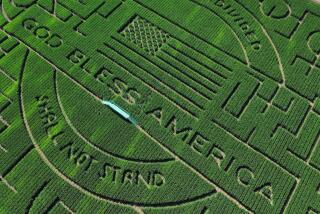13,000 Bushels of ‘Hazardous’ Grain Hauled Away From Iowa Farm : Agriculture: Federal officials sold the corn knowing it contained a carcinogen. The case has raised concerns about inspection safeguards.
- Share via
CHICAGO — Workers wearing protective “moon suits” and backed up by volunteer firefighters Friday removed 13,000 bushels of what could be the most toxic grain ever tested from an Iowa farm and trucked it to a hazardous waste dump near here.
The delicate $90,000 operation took place more than two months after Iowa officials declared the corn--tainted by a mold-induced carcinogen called aflatoxin--a “hazardous material,” the same designation reserved for dangerous chemicals and industrial pollutants.
The Iowa Department of Natural Resources impounded the corn in March after Lowden, Iowa, resident Harlan Pruess purchased it from the Farmers Home Administration and had it hauled to his home from Oklahoma, where it was grown. Both Pruess and FmHA were aware that the corn was bad when the sale was completed. Pruess intended to mix it into animal feed.
Tests have measured contamination of the corn at levels more than 100 times greater than that considered safe for livestock and 1,600 times above the limit for human consumption. Last month, Iowa Agriculture Secretary Dale Cochran called the tainted corn the “highest concentration of aflatoxin that’s ever been recorded in the country and perhaps the world.”
The case has raised concerns over the adequacy of federal grain inspection safeguards. It also has focused attention on the federally sanctioned practice of allowing farmers like Pruess to “salvage” tainted grain for feed by blending it with enough pure grain to dilute toxic concentrations below prescribed safety limits. Iowa officials contend the corn was so “hot” that it never could have been rendered safe.
“One has to question how a federal authority can sell contaminated corn to someone else knowing that the party purchasing it intends to use it somewhere in the food chain,” said Alan Stokes, director of the environmental protection division of the Iowa Department of Natural Resources.
Aflatoxin is a common topsoil fungus that can also affect peanuts and cotton. It is highly toxic and can cause liver cancer if inhaled, eaten or absorbed through the skin. However, it rarely becomes a problem unless susceptible crops are stressed by drought or are mishandled when picked or stored. Mishandling appears to have been the problem with the Pruess corn, regulators said.
The FmHA took possession of the corn after it foreclosed on an Oklahoma farm last year. Later, corn from the same batch was identified by federal and Oklahoma food safety officials as the source of aflatoxin contamination in milk from dairy cows that had ingested tainted feed.
Nevertheless, the FmHA sold the grain to Pruess, who brought it to Iowa apparently in violation of federal guidelines that ban the interstate transport of aflatoxin-tainted grain.
The state immediately quarantined the corn. While state officials bickered with Pruess and the FmHA over what to do with it, the corn sat undisturbed in a 70-foot-long, 10-foot-high mound on a feedlot behind Pruess’ house.
Stokes said Pruess wanted to dispose of the corn by simply burying it on his farm. That low-cost solution was rejected because “neither his experts nor our experts could predict what would happen when it was put in the ground,” Stokes said. “It is more prudent to handle it in the manner we have.” Burning the corn was not an option due to a lack of proper incinerators.
Last week, the Iowa Department of Natural Resources received permission from the Illinois Environmental Protection Agency to bury the corn in a hazardous waste site in Calumet City, south of Chicago. Lawyers for the Iowa environmental agency then obtained a court order allowing them to seize the corn.
Work was to have begun Thursday, but was postponed because winds were gusting to 50 m.p.h. and officials didn’t want to risk having toxic particles flying around.
But shortly after midnight, a five-member crew of private hazardous waste removal specialists began digging into the pile with an end loader, according to Joe Wilkinson, a Department of Natural Resources spokesman who watched the operation from a safe distance.
Wilkinson said the men were clad from head-to-toe in yellow protective clothing and sucked oxygen from a breathing apparatus. Members of Lowden’s volunteer fire department waited nearby, occasionally dousing the corn with water to damp down dust and smoke that sometimes wafted from the pile. The corn was loaded onto a procession of 17 grain trucks lined with plastic sleeves and covered with tarps. Once filled, the plastic was sealed with epoxy like a giant zip-lock bag filled with leftovers gone bad.
Wilkinson estimated costs of the removal operation at about $90,000. He said the state would demand reimbursement from Pruess and the FmHA, but expected the matter to end up in court.
More to Read
Sign up for Essential California
The most important California stories and recommendations in your inbox every morning.
You may occasionally receive promotional content from the Los Angeles Times.













